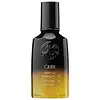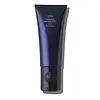What's inside
What's inside
 Key Ingredients
Key Ingredients

 Benefits
Benefits

 Concerns
Concerns

 Ingredients Side-by-side
Ingredients Side-by-side

Cyclopentasiloxane
EmollientCoconut Alkanes
EmollientDimethiconol
EmollientCaprylic/Capric Triglyceride
MaskingCrambe Abyssinica Seed Oil
Skin ConditioningLimnanthes Alba Seed Oil
Skin ConditioningButyrospermum Parkii Butter
Skin ConditioningArgania Spinosa Kernel Oil
EmollientTocopherol
AntioxidantCitrullus Lanatus Fruit Extract
Skin ConditioningCitrus Aurantium Bergamia Fruit Oil
MaskingLitchi Chinensis Fruit Extract
Skin ConditioningOrbignya Speciosa Kernel Oil
EmollientAstrocaryum Murumuru Seed Butter
EmollientSantalum Album Wood Extract
PerfumingOlea Europaea Fruit Oil
MaskingRibes Nigrum Seed Oil
EmollientCitrus Limon Peel Oil
MaskingJasminum Officinale Oil
MaskingLeontopodium Alpinum Flower/Leaf Extract
Skin ConditioningCoco-Caprylate/Caprate
EmollientTbhq
AntioxidantParfum
MaskingLimonene
PerfumingHexyl Cinnamal
PerfumingLinalool
PerfumingCitral
PerfumingCyclopentasiloxane, Coconut Alkanes, Dimethiconol, Caprylic/Capric Triglyceride, Crambe Abyssinica Seed Oil, Limnanthes Alba Seed Oil, Butyrospermum Parkii Butter, Argania Spinosa Kernel Oil, Tocopherol, Citrullus Lanatus Fruit Extract, Citrus Aurantium Bergamia Fruit Oil, Litchi Chinensis Fruit Extract, Orbignya Speciosa Kernel Oil, Astrocaryum Murumuru Seed Butter, Santalum Album Wood Extract, Olea Europaea Fruit Oil, Ribes Nigrum Seed Oil, Citrus Limon Peel Oil, Jasminum Officinale Oil, Leontopodium Alpinum Flower/Leaf Extract, Coco-Caprylate/Caprate, Tbhq, Parfum, Limonene, Hexyl Cinnamal, Linalool, Citral
Water
Skin ConditioningDimethicone
EmollientCyclopentasiloxane
EmollientDimethiconol
EmollientButylene Glycol
HumectantPhenyl Trimethicone
Skin ConditioningAcrylamide/Sodium Acryloyldimethyltaurate Copolymer
Emulsion StabilisingParfum
MaskingIsohexadecane
EmollientOleth-10
EmulsifyingChlorphenesin
AntimicrobialPolysorbate 80
EmulsifyingCyclohexasiloxane
EmollientTetrasodium EDTA
Panthenol
Skin ConditioningSorbic Acid
PreservativeSorbitan Oleate
EmulsifyingGlycerin
HumectantBenzophenone-4
UV AbsorberHelianthus Annuus Seed Extract
Skin ConditioningCinnamidopropyltrimonium Chloride
Styrax Benzoin Resin Extract
MaskingWheat Amino Acids
Skin ConditioningHydrolyzed Jojoba Protein
Skin ConditioningHydrolyzed Rice Protein
Skin ConditioningTin Oxide
AbrasiveHydrolyzed Soy Protein
HumectantCystine Bis-Pg-Propyl Silanetriol
Skin ConditioningHydrolyzed Vegetable Protein Pg-Propyl Silanetriol
Skin ConditioningPhenoxyethanol
PreservativeHydrolyzed Vegetable Protein
Skin ConditioningPhospholipids
Skin ConditioningKaempferia Galanga Root Extract
Skin ConditioningLeontopodium Alpinum Extract
Skin ConditioningPotassium Sorbate
PreservativeCitrullus Lanatus Fruit Extract
Skin ConditioningSodium Benzoate
MaskingCitric Acid
BufferingPotassium Benzoate
PreservativeLeuconostoc/Radish Root Ferment Filtrate
AntimicrobialCitrulline
Skin ConditioningDisodium EDTA
Ethylhexylglycerin
Skin ConditioningTocopheryl Acetate
AntioxidantPPG-3 Benzyl Ether Myristate
EmollientLitchi Chinensis Pericarp Extract
Skin ConditioningMoringa Oleifera Seed Extract
Skin ConditioningBenzyl Alcohol
PerfumingAscorbyl Palmitate
AntioxidantRetinyl Palmitate
Skin ConditioningDisodium Phosphate
BufferingPentaerythrityl Tetra-Di-T-Butyl Hydroxyhydrocinnamate
AntioxidantBenzyl Benzoate
AntimicrobialLimonene
PerfumingLinalool
PerfumingHexyl Cinnamal
PerfumingCitral
PerfumingMica
Cosmetic ColorantCI 77891
Cosmetic ColorantWater, Dimethicone, Cyclopentasiloxane, Dimethiconol, Butylene Glycol, Phenyl Trimethicone, Acrylamide/Sodium Acryloyldimethyltaurate Copolymer, Parfum, Isohexadecane, Oleth-10, Chlorphenesin, Polysorbate 80, Cyclohexasiloxane, Tetrasodium EDTA, Panthenol, Sorbic Acid, Sorbitan Oleate, Glycerin, Benzophenone-4, Helianthus Annuus Seed Extract, Cinnamidopropyltrimonium Chloride, Styrax Benzoin Resin Extract, Wheat Amino Acids, Hydrolyzed Jojoba Protein, Hydrolyzed Rice Protein, Tin Oxide, Hydrolyzed Soy Protein, Cystine Bis-Pg-Propyl Silanetriol, Hydrolyzed Vegetable Protein Pg-Propyl Silanetriol, Phenoxyethanol, Hydrolyzed Vegetable Protein, Phospholipids, Kaempferia Galanga Root Extract, Leontopodium Alpinum Extract, Potassium Sorbate, Citrullus Lanatus Fruit Extract, Sodium Benzoate, Citric Acid, Potassium Benzoate, Leuconostoc/Radish Root Ferment Filtrate, Citrulline, Disodium EDTA, Ethylhexylglycerin, Tocopheryl Acetate, PPG-3 Benzyl Ether Myristate, Litchi Chinensis Pericarp Extract, Moringa Oleifera Seed Extract, Benzyl Alcohol, Ascorbyl Palmitate, Retinyl Palmitate, Disodium Phosphate, Pentaerythrityl Tetra-Di-T-Butyl Hydroxyhydrocinnamate, Benzyl Benzoate, Limonene, Linalool, Hexyl Cinnamal, Citral, Mica, CI 77891
 Reviews
Reviews

Ingredients Explained
These ingredients are found in both products.
Ingredients higher up in an ingredient list are typically present in a larger amount.
Citral is a fragrance and used to add a lemon-like scent to products. It is both naturally found in plants and created synthetically. In plants, it is commonly occurring in lemon myrtle, lemongrass, lemon tea-tree, lemon verbena, and other citruses.
The EU mandates Citral be listed separately as a fragrance. It is a known allergen and may cause contact dermatitis. Citral can also used as a masking ingredient.
The term 'fragrance' is not regulated in many countries. In many cases, it is up to the brand to define this term. For instance, many brands choose to label themselves as "fragrance-free" because they are not using synthetic fragrances. However, their products may still contain ingredients such as essential oils that are considered a fragrance.
The term 'citral' is a collective term for two geometric isomers: geranial/Citral A and neral/Citral B.
Learn more about CitralCitrullus Lanatus Fruit Extract comes from the watermelon. Watermelon has antioxidant and anti-inflammatory properties.
Watermelons are rich in antioxidants such as Vitamin A, Vitamin C and lycopene. It also contains sugars and amino acids, such as arginine and glutathione.
Lycopene is a potent antioxidant. Besides helping to protect your skin against free-radical molecules, it also helps soothe the skin. Lycopene gives watermelon the distinct red color.
Learn more about Citrullus Lanatus Fruit ExtractCyclopentasiloxane, or D5, is a silicone used to improve texture of products and trap moisture.
D5 is considered lightweight and volatile. Volatile means it evaporates quickly after application. Once evaporated, D5 leaves a thin barrier that helps keep skin hydrated.
It is also an emollient. Emollients help soften the skin and prevent water loss. Silicones create a silky texture in products. D5 helps other ingredients become more spreadable.
Studies show D5 is safe to use in skincare products. We recommend speaking with a skincare professional if you have concerns.
Learn more about CyclopentasiloxaneDimethiconol is a silicone that resembles the popular dimethicone. Like other silicones, it is an emollient. Emollients create a thin film on skin to prevent moisture from escaping.
This ingredient helps to create a silky texture and improve spreadability. Due to its high molecular weight and thickness, it is often combined with cyclopentasiloxane.
Hexyl Cinnamal is a fragrance ingredient with a similar scent to jasmine. It can be naturally found in chamomile essential oil.
This ingredient is a known EU allergen and may sensitize the skin. The EU requires this ingredient to be listed separately on an ingredients list.
Hexyl Cinnamal is not water soluble but is soluble in oils.
Learn more about Hexyl CinnamalLimonene is a fragrance that adds scent and taste to a formulation.
It's found in the peel oil of citrus fruits and other plants such as lavender and eucalyptus. The scent of limonene is generally described as "sweet citrus".
Limonene acts as an antioxidant, meaning it helps neutralize free radicals.
When exposed to air, oxidized limonene may sensitize the skin. Because of this, limonene is often avoided by people with sensitive skin.
The term 'fragrance' is not regulated in many countries. In many cases, it is up to the brand to define this term. For instance, many brands choose to label themselves as "fragrance-free" because they are not using synthetic fragrances. However, their products may still contain ingredients such as essential oils that are considered a fragrance.
Learn more about LimoneneLinalool is a fragrance and helps add scent to products. It's derived from common plants such as cinnamon, mint, citrus, and lavender.
Like Limonene, this ingredient oxidizes when exposed to air. Oxidized linalool can cause allergies and skin sensitivity.
This ingredient has a scent that is floral, spicy tropical, and citrus-like.
Learn more about LinaloolParfum is a catch-all term for an ingredient or more that is used to give a scent to products.
Also called "fragrance", this ingredient can be a blend of hundreds of chemicals or plant oils. This means every product with "fragrance" or "parfum" in the ingredients list is a different mixture.
For instance, Habanolide is a proprietary trade name for a specific aroma chemical. When used as a fragrance ingredient in cosmetics, most aroma chemicals fall under the broad labeling category of “FRAGRANCE” or “PARFUM” according to EU and US regulations.
The term 'parfum' or 'fragrance' is not regulated in many countries. In many cases, it is up to the brand to define this term.
For instance, many brands choose to label themselves as "fragrance-free" because they are not using synthetic fragrances. However, their products may still contain ingredients such as essential oils that are considered a fragrance by INCI standards.
One example is Calendula flower extract. Calendula is an essential oil that still imparts a scent or 'fragrance'.
Depending on the blend, the ingredients in the mixture can cause allergies and sensitivities on the skin. Some ingredients that are known EU allergens include linalool and citronellol.
Parfum can also be used to mask or cover an unpleasant scent.
The bottom line is: not all fragrances/parfum/ingredients are created equally. If you are worried about fragrances, we recommend taking a closer look at an ingredient. And of course, we always recommend speaking with a professional.
Learn more about Parfum